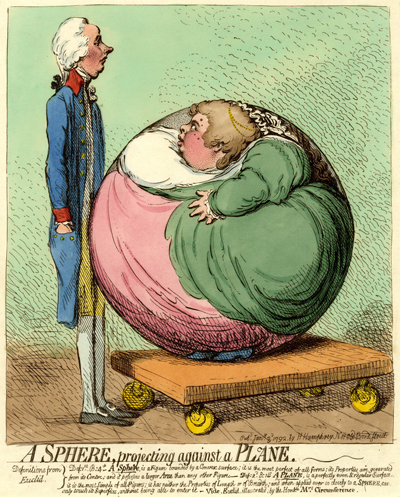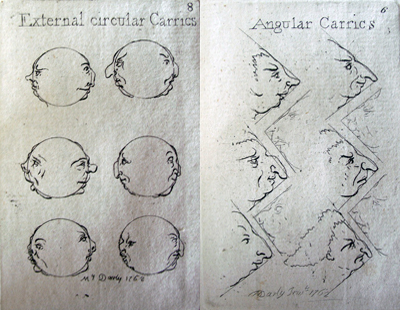A Sphere Projecting against a Plane
One of the delights of caricature is to find the complex made simple. And one of the ways caricature does this is by simplifying the form of its subjects.

© Trustees of the British Museum
Indeed the earliest books on caricature by Mary Darly and Francis Grose teach the would-be caricaturist to see the simplified form beneath the variable human face, and to experiment with the alteration and juxtapositiion of those forms.

A Book of Caricaturas [1762]
© Princeton University
On one level, then, A Sphere Projecting against a Plane can be seen as a parody of the caricaturist's (and by extension Gillray's) own techniques as exemplified by two of his favorite subjects, the very round Mrs. Albinia Hobart, later the Countess of Buckinghamshire, and the very straight Prime Minister, William Pitt. Gillray calls attention to the geometric regularity of this technique by seeming to quote from Euclid's famous Elements in thirteen books, even providing footnotes to book number and definition number in the accompanying caption.
Definitions from Euclid. Def: Ist B: 4th. A Sphere, is a Figure bounded by a Convex surface; it is the most perfect of all forms; its Properties are generated from its Centre; and it possesses a larger Area than any other Figure. - Def: 2d B: Ist A Plane, is a perfectly even & regular Surface, it is the most Simple of all Figures ; it has neither the Properties of Length or of Breadth ; and when applied ever so closely to a Sphere, can only touch its Superficies, without being able to enter it.
But not unexpectedly, the references to Euclid are plausible-sounding fictions. The fourth definition in Book One of Euclid's Elements describes a "straight line" not a sphere. The first definition of Book Two describes a "rectangular parallelogram," not a plane. There are no definitions anywhere in Euclid that correspond to Gillray's. So it is likely that the caption refers, as Thomas Wright suggests, "to some forgotten rumour of the day." And the strategic point of contact between the two figures make it even more likely that the allusion is sexual, or, in Pitt's case, asexual.
By all accounts, Mrs. Hobart was a flamboyant character, intensely interested in fashion, and known for taking roles in home theatricals of much younger and slimmer women, such as Cowslip in The Agreeable Surprise and Miss Larolles in Fanny Burney's Cecilia. She traveled in elite company, maintaining a Faro table in her home which was frequented by the Prince of Wales and politicians like Fox and Sheridan.
From 1789 to 1783, Mrs Hobart's son, Robert, was Pitt's chief secretary to Ireland. In December 1791 in the weeks before Gillray's print appeared, he met with Pitt several times and, according to the Morning Post and Daily Advertiser for December 17 was "doubtless. . . sufficiently instructed in the manner of managing the next [Irish] session." A week or so later on December 28th, the same newspaper announced that Robert would be returning to Ireland, his head crammed with instructions from Mr. Pitt. On the same day, the Evening Mail reported that "This evening Mrs. Hobart will give a ball and supper at her house in St. James's Square." It's hard not to assume that the supper and ball were at least partly intended as a send off for her son. And if that was the case, one would think that Pitt, as Robert's employer, would have been invited to attend.
Admittedly, all of this is highly speculative. But it's not difficult to imagine the effervescent Mrs. Hobart in the flush of port and partying projecting her round form rather too close against the linear person of the Prime Minister at some time during the evening. And given Pitt's reputation for indifference to even young and eligible females, there is no doubt that he could only touch the "superficies" of that eager projecting sphere with the pained reluctance we see on his face, and certainly "without being able to enter it."
Sources and Reading
- Commentary from the British Museum on A Sphere Projecting against a Plane.
- Draper Hill, The Satirical Etchings of James Gillray, 1976, #23
- "Albinia Hobart," Wikipedia
- "William Pitt the Younger," Wikipedia
- Euclid's Elements of Geometry
- Thomas Wright and R.H. Evans, Historical and Descriptive Account of the Caricatures of James Gillray #72
Comments & Corrections
NOTE: Comments and/or corrections are always appreciated. To make that easier, I have included a form below that you can use. I promise never to share any of the info provided without your express permission.